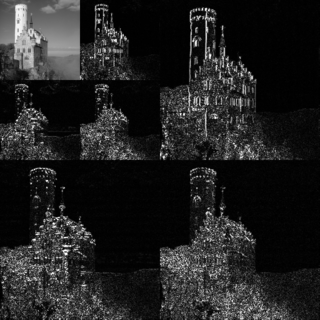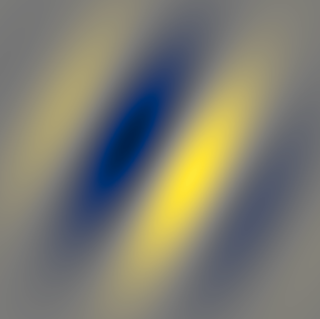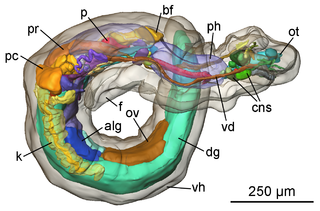Related Research Articles

A wavelet is a wave-like oscillation with an amplitude that begins at zero, increases or decreases, and then returns to zero one or more times. Wavelets are termed a "brief oscillation". A taxonomy of wavelets has been established, based on the number and direction of its pulses. Wavelets are imbued with specific properties that make them useful for signal processing.

Fractal compression is a lossy compression method for digital images, based on fractals. The method is best suited for textures and natural images, relying on the fact that parts of an image often resemble other parts of the same image. Fractal algorithms convert these parts into mathematical data called "fractal codes" which are used to recreate the encoded image.

Stéphane Georges Mallat is a French applied mathematician, concurrently appointed as Professor at Collège de France and École normale supérieure. He made fundamental contributions to the development of wavelet theory in the late 1980s and early 1990s. He has additionally done work in applied mathematics, signal processing, music synthesis and image segmentation.

In numerical analysis and functional analysis, a discrete wavelet transform (DWT) is any wavelet transform for which the wavelets are discretely sampled. As with other wavelet transforms, a key advantage it has over Fourier transforms is temporal resolution: it captures both frequency and location information.
The fast wavelet transform is a mathematical algorithm designed to turn a waveform or signal in the time domain into a sequence of coefficients based on an orthogonal basis of small finite waves, or wavelets. The transform can be easily extended to multidimensional signals, such as images, where the time domain is replaced with the space domain. This algorithm was introduced in 1989 by Stéphane Mallat.

In image processing, a Gabor filter, named after Dennis Gabor, who first proposed it as a 1D filter. The Gabor filter was first generalized to 2D by Gösta Granlund, by adding a reference direction. The Gabor filter is a linear filter used for texture analysis, which essentially means that it analyzes whether there is any specific frequency content in the image in specific directions in a localized region around the point or region of analysis. Frequency and orientation representations of Gabor filters are claimed by many contemporary vision scientists to be similar to those of the human visual system. They have been found to be particularly appropriate for texture representation and discrimination. In the spatial domain, a 2D Gabor filter is a Gaussian kernel function modulated by a sinusoidal plane wave.
The Stationary wavelet transform (SWT) is a wavelet transform algorithm designed to overcome the lack of translation-invariance of the discrete wavelet transform (DWT). Translation-invariance is achieved by removing the downsamplers and upsamplers in the DWT and upsampling the filter coefficients by a factor of in the th level of the algorithm. The SWT is an inherently redundant scheme as the output of each level of SWT contains the same number of samples as the input – so for a decomposition of N levels there is a redundancy of N in the wavelet coefficients. This algorithm is more famously known as "algorithme à trous" in French which refers to inserting zeros in the filters. It was introduced by Holschneider et al.

In mathematics, a wavelet series is a representation of a square-integrable function by a certain orthonormal series generated by a wavelet. This article provides a formal, mathematical definition of an orthonormal wavelet and of the integral wavelet transform.

The lifting scheme is a technique for both designing wavelets and performing the discrete wavelet transform (DWT). In an implementation, it is often worthwhile to merge these steps and design the wavelet filters while performing the wavelet transform. This is then called the second-generation wavelet transform. The technique was introduced by Wim Sweldens.

Matching pursuit (MP) is a sparse approximation algorithm which finds the "best matching" projections of multidimensional data onto the span of an over-complete dictionary . The basic idea is to approximately represent a signal from Hilbert space as a weighted sum of finitely many functions taken from . An approximation with atoms has the form

A bilateral filter is a non-linear, edge-preserving, and noise-reducing smoothing filter for images. It replaces the intensity of each pixel with a weighted average of intensity values from nearby pixels. This weight can be based on a Gaussian distribution. Crucially, the weights depend not only on Euclidean distance of pixels, but also on the radiometric differences. This preserves sharp edges.
Contourlets form a multiresolution directional tight frame designed to efficiently approximate images made of smooth regions separated by smooth boundaries. The contourlet transform has a fast implementation based on a Laplacian pyramid decomposition followed by directional filterbanks applied on each bandpass subband.
Curvelets are a non-adaptive technique for multi-scale object representation. Being an extension of the wavelet concept, they are becoming popular in similar fields, namely in image processing and scientific computing.

In computer vision and computer graphics, 3D reconstruction is the process of capturing the shape and appearance of real objects. This process can be accomplished either by active or passive methods. If the model is allowed to change its shape in time, this is referred to as non-rigid or spatio-temporal reconstruction.
The wavelet transform modulus maxima (WTMM) is a method for detecting the fractal dimension of a signal.
In applied mathematical analysis, shearlets are a multiscale framework which allows efficient encoding of anisotropic features in multivariate problem classes. Originally, shearlets were introduced in 2006 for the analysis and sparse approximation of functions . They are a natural extension of wavelets, to accommodate the fact that multivariate functions are typically governed by anisotropic features such as edges in images, since wavelets, as isotropic objects, are not capable of capturing such phenomena.
Gabor wavelets are wavelets invented by Dennis Gabor using complex functions constructed to serve as a basis for Fourier transforms in information theory applications. They are very similar to Morlet wavelets. They are also closely related to Gabor filters. The important property of the wavelet is that it minimizes the product of its standard deviations in the time and frequency domain. Put another way, the uncertainty in information carried by this wavelet is minimized. However they have the downside of being non-orthogonal, so efficient decomposition into the basis is difficult. Since their inception, various applications have appeared, from image processing to analyzing neurons in the human visual system.
Scale co-occurrence matrix (SCM) is a method for image feature extraction within scale space after wavelet transformation, proposed by Wu Jun and Zhao Zhongming. In practice, we first do discrete wavelet transformation for one gray image and get sub images with different scales. Then we construct a series of scale based concurrent matrices, every matrix describing the gray level variation between two adjacent scales. Last we use selected functions to calculate measurements with SCM and do feature extraction and classification. One basis of the method is the fact: way texture information changes from one scale to another can represent that texture in some extent thus it can be used as a criterion for feature extraction. The matrix captures the relation of features between different scales rather than the features within a single scale space, which can represent the scale property of texture better. Also, there are several experiments showing that it can get more accurate results for texture classification than the traditional texture classification.
Wavelets are often used to analyse piece-wise smooth signals. Wavelet coefficients can efficiently represent a signal which has led to data compression algorithms using wavelets. Wavelet analysis is extended for multidimensional signal processing as well. This article introduces a few methods for wavelet synthesis and analysis for multidimensional signals. There also occur challenges such as directivity in multidimensional case.
In applied mathematics, biorthogonal nearly coiflet bases are wavelet bases proposed by Lowell L. Winger. The wavelet is based on biorthogonal coiflet wavelet bases, but sacrifices its regularity to increase the filter's bandwidth, which might lead to better image compression performance.
References
- Le Pennec, E.; Mallat, S. (April 2005). "Sparse geometric image representations with bandelets" (PDF). IEEE Transactions on Image Processing. 14 (4): 423–438. Bibcode:2005ITIP...14..423L. CiteSeerX 10.1.1.2.5888 . doi:10.1109/TIP.2005.843753. PMID 15825478. S2CID 2112160.
- Peyré, G.; Mallat, S. P. (July 2005). "Surface compression with geometric bandelets" (PDF). ACM Transactions on Graphics . Proceedings of ACM SIGGRAPH 2005. 24 (3): 601–608. doi:10.1145/1073204.1073236. Archived from the original (PDF) on 2006-11-29.